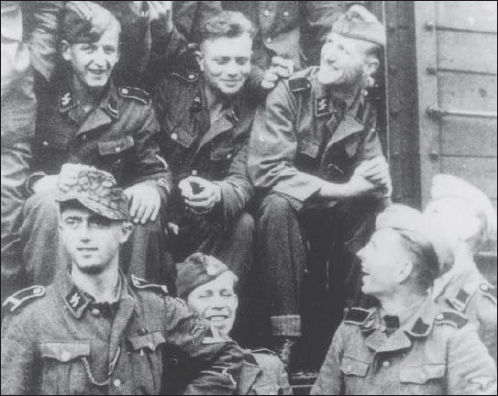

THE WAFFEN-SS STRUCTURE
THE WAFFEN-SS DIVISIONS: 1. SS-PANZER DIVISION LEIBSTANDARTE SS ADOLF HITLER
2. SS-PANZER DIVISION DAS REICH
3. SS-PANZER DIVISION TOTENKOPF
4. SS-POLIZEI PANZERGRENADIER DIVISION
5. SS-PANZER DIVISION WIKING
THE PLATES
THERE IS NO SPACE in these pages for even a simplified summary of the complex early history of the German NSDAP (National Socialist) movement in the 1920s and 1930s. For the purposes of this text it is sufficient to say that the combat units which had emerged by the outbreak of World War II from the overall SS political security organisation (the Schutz Staffeln or ‘protection squads’) traced their origins to the early 1920s, when a small bodyguard unit for Adolf Hitler was formed within the Nazi Party’s mass uniformed organisation, the SA (Sturmabteilungen or ‘Brownshirts’).1 In 1929 the whole SS numbered less than 300 men; by 1933 this figure had increased to some 30,000. Under the national command of Heinrich Himmler the SS, with three battalions of armed gendarmerie, provided the key personnel for the internal coup against the SA leadership carried out on 30 June 1934.
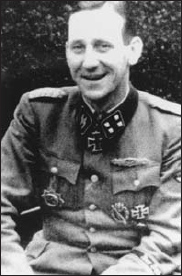
SS-Sturmbannführer Herbert Schulze, commander of II/SS-Panzergrenadier Regiment 4 Der Führer. In this photograph, taken in late 1943 or early 1944, Schulze still wears the pre-war Gothic script version of the regimental cuffband. (Josef Charita)
Thereafter the growth in the size and influence of the SS in most areas of German public life was massive, complicated, and virtually unchallenged. Nevertheless, at the outbreak of war in 1939 the armed units of what were mostly then termed the SS-Verfügungstruppe were still few and militarily insignificant. They were regarded by the armed forces with some suspicion, as a political gendarmerie with no true role to play on the battlefield. Early combat experience in the West, and particularly in the first year of the Russian campaign, changed that perception, leading to a number of different cycles of expansion of what was now the Waffen-SS. By late 1943 this battle-proven organisation was fielding several complete armoured and mechanised divisions and was enjoying priority for the best-quality manpower and equipment.
SS formations became the trusted spearhead of Germany’s armies on the Eastern Front, and served on every other major front except North Africa. Between early 1943 and spring 1945 the ostensible order of battle of the Waffen-SS grew from eight to no less than 38 divisions ‘on paper’ – though many of the higher numbered (mostly foreign) formations fell far below the standards set by the early divisions. A number of corps-level formations, and even one or two nominal ‘SS armies’ containing both SS and Army units, would see action in 1943–45.
The Waffen-SS as a whole earned a dual reputation: for remarkable aggression and stamina in combat, and for murderous atrocity against civilians and prisoners. This series of Men-at-Arms titles will concern itself solely with brief organisation and campaign histories of the separate divisions, and the evolving uniforms, insignia and personal equipment of their officers and men.
Although its divisions came under the tactical command of the Oberkommando der Wehrmacht in the field, the Waffen-SS had its own unique internal command structure, at the pinnacle of which sat the Reichsführer-SS, Heinrich Himmler. Operational command of the entire SS came under the auspices of the SS-Führungshauptamt, a new main office created in the summer of 1940 around the time that the Waffen-SS itself emerged from its forerunner, the SS-Verfügungstruppe.
The rank structure and rank titles of the Waffen-SS were directly adapted from those of the political Allgemeine-SS. Although the Allgemeine-SS method of displaying rank banding by single straps on the right shoulder only was eventually replaced by matched pairs of straps in the Army fashion; the old Allgemeine-SS style of left-hand collar patches showing specific rank was retained, with only minor changes, until May 1945.
As well as the adoption of Army-style shoulder straps, a further move to emphasise the ‘military’ rather than ‘political’ nature of the Waffen-SS was marked when the original SS ranks equivalent to Army generals were given a suffix indicating the equivalent general’s rank of the Waffen-SS. Thus, the original rank of SS-Brigadeführer became in the Waffen-SS SS-Brigadeführer und Generalmajor der Waffen-SS.
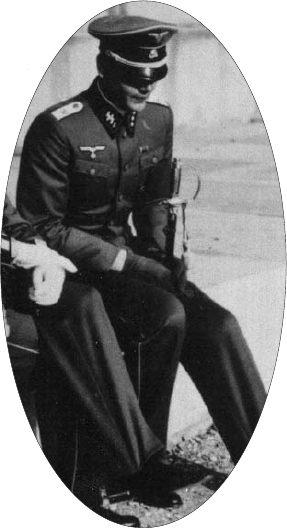
An extremely unusual and interesting photograph showing an SS-Untersturmführer undergoing training at an Army establishment. Whilst on attachment, he wears an Army breast eagle on his SS uniform. His collar patch bears the runes and ‘1’ of the Deutschland Standarte. (Gary Wood)
Generally speaking, in the Army and Waffen-SS similar positions were held by soldiers with equivalent ranks. Thus a Hauptmann (captain) commanding a company-sized unit in the Army would have as his equivalent in a Waffen-SS unit an officer with the rank of SS-Hauptsturmführer; and an Oberst (colonel) in the Army, commanding a regiment, would have as his equivalent an SS-Standartenführer. The original SS ranks indicated precisely the size of the unit that the soldier would command, suffixed by the term Führer or leader: thus Scharführer, Sturmführer, Sturmbannführer, Standartenführer, Gruppenführer, etc.

Left collar rank insignia for commissioned ranks. (Top, left to right:) Untersturmführer, Obersturmführer, Hauptsturmführer, Sturmbannführer. (Second row:) Obersturmbannführer, Standartenführer, Oberführer; Brigadeführer 1942-45/Gruppenführer to 1942. (Bottom row:) Obergruppenführer to 1942/Gruppenführer 1942-45; Obergruppenführer 1942–45; Oberstgruppenführer 1942–45; Reichsführer-SS.
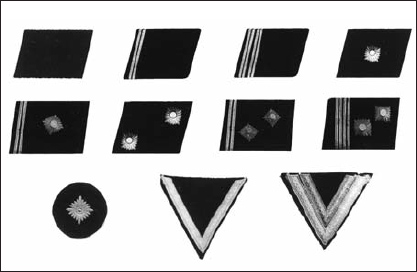
Left collar and left sleeve rank insignia for enlisted men and NCOs, the former in pressed white metal and aluminium lace. (Top row, left to right:) Schütze/Oberschütze, Sturmmann, Rottenführer, Unterscharführer. (Second row:) Scharführer, Oberscharführer, Hauptscharführer, Sturmscharführer 1942-45. (Bottom row:) Oberschütze pip, Sturmmann chevron, Rottenführer chevrons.
Where regulation Waffen-SS insignia were replaced or augmented by insignia unique to a particular unit or formation, these are reflected in the text that follows; but in general, the rank structure listed on the panel below was common throughout the Waffen-SS. It should also be noted that within the later-raised ‘non-Nordic’ volunteer formations, the rank prefix ‘SS-’ was replaced by ‘Waffen-’. Thus a French SS volunteer with the equivalent rank to captain should technically have been referred to not as an SS-Hauptsturmführer but as a Waffen-Hauptsturmführer. In the case of the various foreign volunteer national Legions, the prefix ‘Legions-’ was used, thus Legions-Hauptsturmführer. Most of this nonsensical and unnecessary complication was due to Himmler’s bizarre racial beliefs and the insistence that those SS volunteers who were not considered racially ‘Aryan’ should not be permitted to use the ‘SS’ prefix. It was also primarily for this reason that many foreign volunteer units were forced to adopt special unit collar patches in place of the SS runes. German cadre staff in these units were entitled to wear the runes on the left breast pocket to indicate their status as true members of the SS.
Junior NCO ranks, up to SS-Rottenführer, wore on the upper left sleeve chevrons manufactured with aluminium or subdued grey silk braid (Tresse) on a black wool triangular base. The sleeve rank pip for SS-Oberschütze (unlike the white metal collar patch pips) was machine-embroidered in silver-grey thread on a black wool circular patch.
Waffen-SS ranks & equivalents
| Waffen-SS | Army | British equivalent |
| SS-Schütze | Schütze | Private |
| SS-Oberschütze | Oberschütze | — |
| SS-Sturmmann | Gefreiter | Lance Corporal |
| SS-Rottenführer | Obergefreiter | Corporal |
| SS-Unterscharführer | Unteroffizier | Sergeant |
| SS-Scharführer | Unterfeldwebel | Staff Sergeant |
| SS-Oberscharführer | Feldwebel | Warrant Officer II |
| SS-Hauptscharführer | Oberfeldwebel | — |
| SS-Sturmscharführer | Stabsfeldwebel | WO I |
| SS-Untersturmführer | Leutnant | 2nd Lieutenant |
| SS-Obersturmführer | Oberleutnant | Lieutenant |
| SS-Hauptsturmführer | Hauptmann | Captain |
| SS-Sturmbannführer | Major | Major |
| SS-Obersturmbannführer | Oberstleutnant | Lieutenant Colonel |
| SS-Standartenführer | Oberst | Colonel |
| SS-Oberführer | — | — |
| SS-Brigadeführer | Generalmajor | Brigadier |
| SS-Gruppenführer | Generalleutnant | Major General |
| SS-Obergruppenführer | General | Lieutenant General |
| SS-Oberstgruppenführer | Generaloberst | General |
| — | General-feldmarschall | Field Marshal |
| Reichsführer-SS | — | — |
The basic runic collar patch worn on the right side consisted of a rhomboid-shaped piece of buckram covered with black felt or badge-cloth, on which the runes were either machine-embroidered in silver-grey silk thread or hand-embroidered in aluminium wire. In the latter part of the war collar patches were machine-woven in black artificial silk with the runes in silver-grey or aluminium thread. Although the aluminium machine-woven and hand-embroidered forms are generally referred to as officer grade, they were in fact also worn by noncommissioned and enlisted ranks.
The usual indication of officer ranks was twisted silver cord piping edging the patches; however, officers were occasionally known to wear patches without cord edging, so the only absolute indication of officer rank is the grade indicated on the left-hand patch. Collar patches for general ranks were usually executed on black velvet base material.
Waffen-SS shoulder straps followed the same basic form as those of the Army. For lower ranks they were faced in black badge-cloth with either black or field-grey undersurfaces. The edge was piped in the appropriate Waffenfarbe (branch of service colour); and NCO-grade straps carried braid inner edging – initially in aluminium weave, but later in subdued grey silk. Aluminium pips indicated specific NCO ranks.
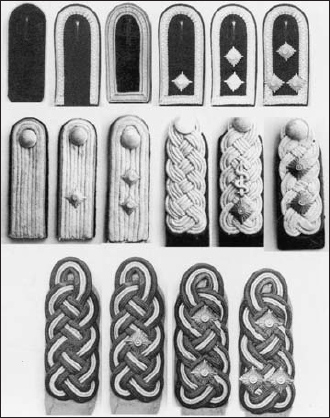
Shoulder straps. (Top row, left to right:) Schütze/Oberschütze, Unterscharführer, Scharführer, Oberscharführer, Hauptscharführer, Sturmscharführer. (Second row:) Untersturmführer, Obersturmführer, Hauptsturmführer, Sturmbannführer, Obersturmbannführer (medical), Standartenführer/Oberführer. (Bottom row:) Brigadeführer, Gruppenführer, Obergruppenführer, Oberstgruppenführer.
Officer candidates (enlisted ranks who had been earmarked for future officer training) carried the rank of SS-Junker, SS-Standartenjunker or SS-Standartenoberjunker, and wore the shoulder straps of SS-Unterscharführer, SS-Scharführer and SS-Hauptscharführer respectively, with the addition of two slides of aluminium braid for the first two. The appropriate NCO-rank collar patches were also worn – in the case of SS-Standartenoberjunker, those of SS-Hauptscharführer but with officer’s silver twist cord edging. NCO candidates wore the shoulder straps of a private with a single aluminium braid slide.
Officers’ straps were made with the same matt grey straight or interwoven braid as their Army equivalents. Unlike Army straps, which were set on an underlay in the appropriate Waffenfarbe, all Waffen-SS straps were on a black underlay, the Waffenfarbe being displayed as an intermediate piping between the braid and the black underlay. Rank pips were originally bronze or gilt, but aluminium examples were also used. Waffen-SS generals’ shoulder straps were made from the same interwoven silver/gold braid as those of the Army but set on pale grey rather than a bright red underlay.
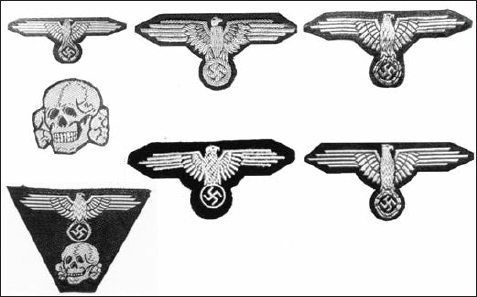
The SS national emblem. (Top, left to right:) Machine-woven cap eagle and matching death’shead; hand-embroidered bullion sleeve eagle; machine-woven aluminium sleeve eagle. (Bottom:) One-piece eagle and death’s-head for M1943 cap; machine-embroidered sleeve eagle; machine-woven rayon sleeve eagle.
1 See MAA 220, The SA 1921–45: Hitler’s Stormtroopers; and MAA 266, The Allgemeine-SS.